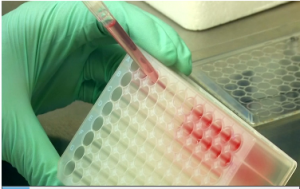
(Reuters) — For the first time, fully functional human cartilage has been grown using stem cells derived from human bone marrow in a laboratory.
According to the research team at Columbia University in New York who developed the new method, cartilage is a simple but important tissue. It is the only tissue in the body that does not have blood vessels or nerves. It is also a load-bearing tissue that protects the bone ends in the joints.
Cartilage does not heal over time. If damaged, doctors must take cartilage from another part of the body or use someone else’s to replace it.
Sarindr Bhumiratana, a postdoctoral fellow in Columbia University’s Department of Biomedical Engineering, came up with the idea to turn human stem cells into cartilage in the same way the body generates cartilage as it grows and develops.
“We call it fabrication technique.. which is based on the developmental process where the stem cells condense. This is.. we base everything we do in the lab to what happens during development when we were a fetus or when we were young. So the cells condense and differentiate into a cartilage piece. So we apply that technique in the lab,” he explained.
“The result of this is that for the very first time, this human cells that we derived from bone marrow aspirates or fat that normally regenerate cartilage in our body, they are able to form cartilage that is as stiff as healthy native cartilage,” said Gordana Vunjak-Novakovic, who led the study and is the Mikati Foundation Professor of Biomedical Engineering at Columbia Engineering and professor of medical sciences.
Scientists have been studying cartilage for more than 20 years. Up until now, engineers have made cartilage from young animal cells. But the result was often weak cartilage.
With Bhumiratana’s method, engineers can grow large pieces of anatomically shaped and mechanically strong cartilage over the bone.
The first step is mesenchymel condensation, a process that mimics how stem cells would naturally develop into cartilage in vitro. Next, the area where a patient needs cartilage replacement is imaged, allowing the scientists to mold a scaffold where the newly generated cartilage grows in to the desired shape.
“It is customized. For both bone and cartilage we use images. So we take images of the patient, normal medical images, and then we make these three dimensional files. We use them to make scaffold and then we grow a piece that is with great precision mimicking what you are replacing. So it’s actually very simple now because it works in a very simple way. It’s a very efficient technology. So it doesn’t take a very long time to grow these pieces, ” said Vunjak-Novakovic.
Scientists said this method will eventually be able to help people whose cartilage has weakened or has been destroyed in all parts of the body including the jaw, knees and fingers.
“This is the kind of technology that should, in principle, make it possible to regenerate any piece of bone interfaced with cartilage in the body. So, we do have technology. We do understand underlying principles. But we are not ready to go into patients. There is a lot of pre-clinical work that will need to be done to make this happen,” cautioned Vunjak-Novakovic.
Vunjak-Novakovic’s team next plans to test the long-term effects of the stem cell grown cartilage to see how the tissue holds up over time.
The study was published in the April 28 Early Online edition of “Proceedings of the National Academy of Sciences” (PNAS).







